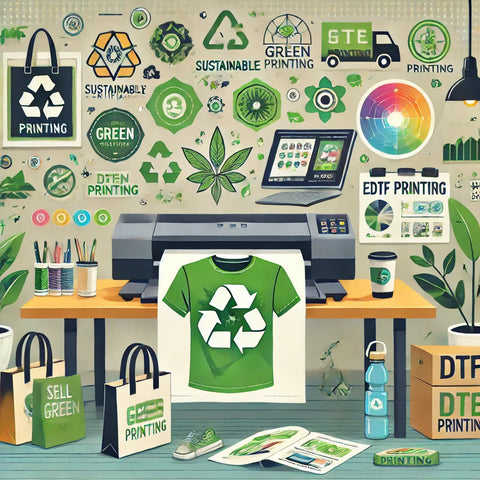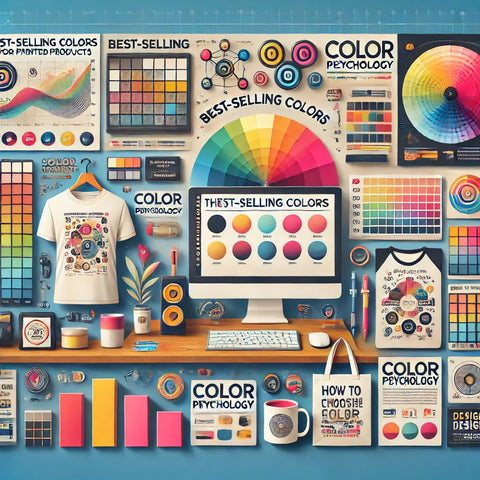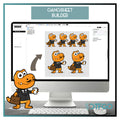Sustainability is no longer just a trend—it’s a necessity in today’s fashion and print industry. Consumers are becoming more aware of their environmental impact, and they actively seek eco-friendly products.
If you’re in the DTF printing business, you might wonder: Can I produce and sell sustainable products while maintaining profitability? The answer is YES!
By choosing the right materials, reducing waste, and adopting green production practices, you can create a successful, environmentally conscious DTF printing business.
Let’s explore how to make your DTF printing brand eco-friendly while keeping it profitable.
1. Why Choose Eco-Friendly DTF Printing?
✔ Attracts eco-conscious customers – People are willing to pay more for sustainable products.
✔ Reduces environmental impact – Less water, chemicals, and energy consumption than traditional printing.
✔ Builds brand reputation – Sustainable brands get more loyal customers and positive PR.
✔ Meets new regulations – Many regions are enforcing eco-friendly production laws.
📌 Example: A DTF-printed organic cotton tote bag business can market itself as a sustainable alternative to plastic bags, appealing to green-conscious shoppers.
🚀 Pro Tip: Highlight your eco-friendly efforts in product descriptions to attract sustainability-focused buyers.
2. Choosing Sustainable Materials for DTF Printing
One of the most important aspects of eco-friendly DTF printing is choosing the right materials.
✔ Best Sustainable Fabrics for DTF Printing:
| Fabric | Eco-Friendly Benefits |
|---|---|
| Organic Cotton | Grown without pesticides, biodegradable |
| Recycled Polyester (rPET) | Made from recycled plastic bottles |
| Bamboo Fabric | Naturally antibacterial, requires less water |
| Hemp Fabric | Durable, low environmental impact |
| Tencel (Lyocell) | Made from sustainably sourced wood fibers |
📌 Example: A DTF-printed sustainable streetwear brand can use organic cotton hoodies and recycled polyester T-shirts to stand out in the market.
🚀 Pro Tip: Offer "eco-certifications" (GOTS, OEKO-TEX, Fair Trade) on product pages to boost trust and credibility.
3. How to Make DTF Printing More Eco-Friendly?
✔ Sustainable Practices for a Greener DTF Printing Business:
1️⃣ Use Water-Based DTF Inks – Avoid petroleum-based inks, which release harmful chemicals.
2️⃣ Minimize Waste – Optimize DTF transfer films to reduce material waste.
3️⃣ Use Recycled Packaging – Switch to biodegradable, plastic-free shipping materials.
4️⃣ Reduce Energy Usage – Invest in energy-efficient heat press machines.
5️⃣ Encourage Bulk Orders – Fewer shipments mean lower carbon footprint.
📌 Example: A DTF-printed custom merchandise brand can offer bulk order discounts to encourage less frequent shipping and reduce packaging waste.
🚀 Pro Tip: Partner with carbon offset programs to make your DTF printing business climate-neutral.
4. Selling Eco-Friendly DTF Products: Where and How?
Once you’ve established a sustainable printing process, the next step is marketing and selling your products.
✔ Best Platforms for Selling Sustainable DTF Products:
| Platform | Best For |
|---|---|
| Etsy | Eco-conscious shoppers looking for handmade items |
| Shopify | Full control over branding & sustainability messaging |
| Amazon Handmade | Selling unique, environmentally friendly products |
| Instagram & TikTok Shop | Reaching eco-conscious buyers through social media |
📌 Example: A DTF-printed sustainable activewear brand can use Instagram marketing to showcase workout apparel made from recycled polyester.
🚀 Pro Tip: Add an "Eco-Friendly Collection" section on your store to highlight sustainable products.
5. Marketing Strategies for Eco-Friendly DTF Brands
To attract green-conscious consumers, your marketing should focus on sustainability, transparency, and ethics.
✔ Best Marketing Strategies for Eco-Friendly DTF Printing:
1️⃣ Tell Your Sustainability Story – Explain how your brand reduces environmental impact.
2️⃣ Use Green Keywords in SEO – Optimize product listings with terms like "sustainable fashion", "eco-friendly prints", and "biodegradable packaging".
3️⃣ Partner with Eco-Influencers – Collaborate with sustainability advocates on TikTok & Instagram.
4️⃣ Highlight Certifications – If your materials are organic, fair trade, or recycled, showcase these labels prominently.
5️⃣ Educate Your Customers – Write blogs or post videos about why sustainable printing matters.
📌 Example: A DTF-printed custom tote bag brand can post a TikTok showing the difference between plastic bags and their biodegradable fabric alternatives.
🚀 Pro Tip: Customers trust brands that are transparent, so show your eco-friendly process behind the scenes.
6. Pricing Strategy for Eco-Friendly DTF Products
Many consumers expect sustainable products to cost slightly more due to better materials and ethical production.
✔ How to Price Eco-Friendly DTF Products Profitably:
| Strategy | Why It Works |
|---|---|
| Premium Pricing | Positions your brand as high-quality & sustainable |
| Bundle Discounts | Encourages bulk purchases, reducing shipping waste |
| Subscription Model | Monthly sustainable fashion drops for loyal customers |
| Eco-Discounts | Offer discounts to customers who recycle old apparel |
📌 Example: A DTF-printed organic T-shirt brand can charge $5–10 more per shirt than conventional brands due to premium eco-materials.
🚀 Pro Tip: Explain why your product costs more (better materials, ethical labor) to justify higher prices.
Final Thoughts: Start Your Sustainable DTF Printing Brand Today
📌 Key Takeaways:
✔ Use organic and recycled fabrics to reduce environmental impact.
✔ Switch to water-based DTF inks and biodegradable packaging.
✔ Sell on Etsy, Shopify, Amazon Handmade, and TikTok Shop.
✔ Market your sustainability story through SEO, social media, and influencer collaborations.
✔ Price products competitively while emphasizing eco-friendly value.
🚀 Want to build a successful eco-friendly brand? Start producing sustainable DTF-printed products and attract conscious consumers today!






